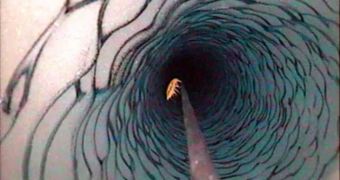In November 2009, the otherwise-gray day of researchers working on surveying the underside of the Antarctic ice sheet was brightened up when they discovered a shrimp-like creature swimming no less than 600 feet underneath the surface of the ice shelf. The animal was going about its business inside a borehole that the experts had drilled as part of a joint NASA / US National Science Foundation (NSF) project to keep an eye on how the ice sheet is influenced by the surrounding ocean.
“We were like little kids huddling around, just oohing and aahing at this little creature swimming around and giving us a little show. It was the thrill of discovery that made us giddy; just totally unexpected,” says NASA expert Bob Bindschadler, who holds an appointment at the Greenbelt, Maryland-based Goddard Space Flight Center. He was the leader of the team that conducted the west-Antarctic survey. The three-inch long creature was eventually identified as the complex creature Lyssianasid amphipod, the expert adds.
The observations post was set up some 20 miles northeast of McMurdo Station, in a region known as Windless Bight. The researchers were surveying the 180-meter (590-foot) thick Ross Ice Shelf, and a borehole some eight inches in diameter had been drilled through. This was done so that the team led by NASA Jet Propulsion Laboratory (JPL) expert Alberto Behar could submerge a camera through it, and obtain the first-ever footage of the underbelly of an ice sheet.
“This is the first time we've had a camera able to look back up at the ice. This probe is an upgrade to the original. It has three cameras – down, side and back-looking. The back-looking camera saw the shrimp-like animal,” Behar says of seeing the shrimp-like creature. The JPL team is conducting such studies in Antarctica in order to learn exactly why the Pine Island ice shelf is losing so much mass, and why it is slowly slipping into the Southern Ocean. This phenomenon is extremely dangerous, as this much ice could considerably raise sea levels, affecting millions living in coastal areas.
“The real benefit of these exploration programs is that you go in not knowing what you're going to find and you get surprised. It makes it worth all the trouble putting everything together when you find something new that you didn't expect,” says Behar, who is renowned for the work he has done with robotic explorers for the Red Planet.

 14 DAY TRIAL //
14 DAY TRIAL //